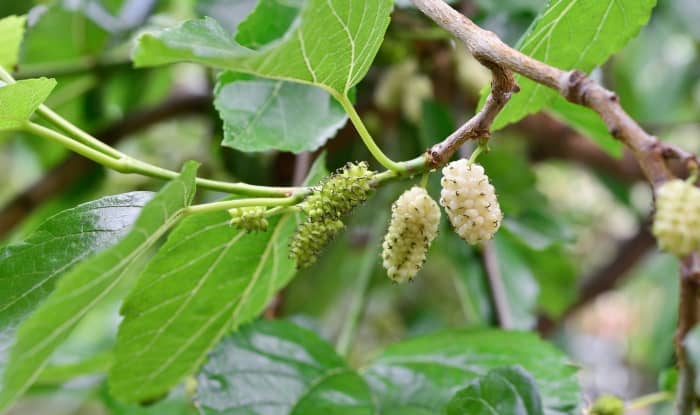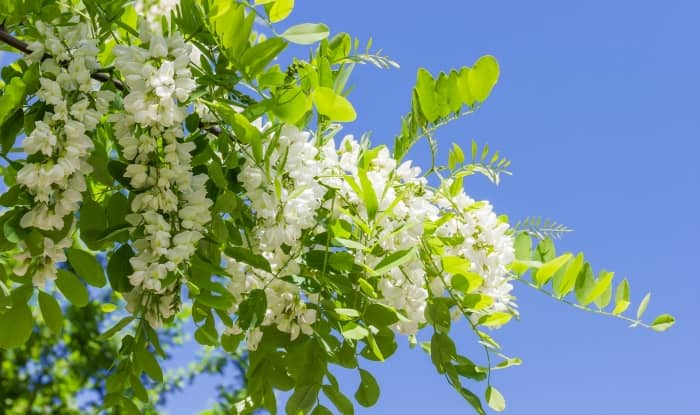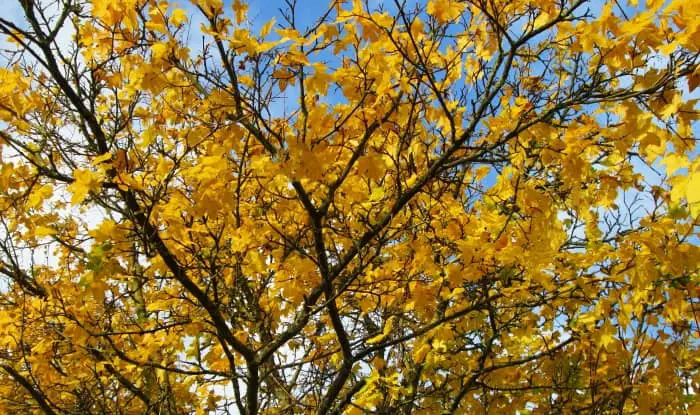“Oh great, another weed tree!”
Said nobody ever.
At least, not without a heavy dose of sarcasm.
The problem?
Many species are aggressive invaders if left unchecked.
They can colonize an area quickly: choking out nearby trees and plants, preventing their growth. And threatening the foundations of buildings.
So something has to be done. And the sooner you do it the easier it is.
In this article, I’ll show you how to identify them when they’re young so that removing them is a quick job by hand. As well as methods to use if they’re already well established.
Let’s dive straight in.
What Are Weed Trees?
Weeds are plants growing in places you don’t want them to be.
Likewise, weed trees are unwanted trees you didn’t plant that are growing in your garden uninvited.
If you find a new tree seedling but you’re happy with it and want to keep it, then it’s not a weed tree. Simple as that. Instead, in gardening terminology, it’s known as a volunteer tree.
But if you suddenly find one growing in a flower bed, the middle of your lawn, or anywhere it’s a nuisance, then go ahead and call it a weed tree.
Woody weed species often have a high seed germination rate. This means they grow fast and can colonize an area rapidly.
This is bad enough if you weren’t planning on a garden full of trees. But that’s not all:
They also choke slower-growing species nearby if you don’t identify them and act.
This aggressive invasion usually starts from seeds carried into your garden by the wind, deposited by birds, or accidentally mixed into your compost.
And depending on where you live, they can be a common occurrence. So keep your eyes open for any small saplings that are starting to grow. It’s a lot easier to get rid of them when they’re very young.
Many weed trees are non-native species planted as ornamental trees somewhere nearby. But it’s a fine line between ornamental tree and weed. Sometimes just the width of a fence.
They’re usually chosen because they’re strong and hard to kill. But this makes them more of a problem for you.
Why?
Because it means they’re a lot tougher to remove.
How To Identify A Weed Tree
Is that new plant growing in your garden a tree sapling?
Follow these steps to find out:
- First, check the stem of the plant. If it’s woody, then there’s a good chance that it’s a tree. If it has a thick green stem, then you can rule it out.
- Next, take a look at its leaves. The leaves of young trees are the same shape as leaves on the fully mature tree. You’ll see them on the end of small branches, instead of growing out from the stem like they do on many other plants.
- Take a look at the surrounding area. Most trees grow fairly close to the mother tree. Can you see one nearby that looks similar? Does it have the same type of leaves? If so, then you’ve probably found your culprit.
Examples Of Unwanted Trees To Look Out For
These are common types of weed trees. They are all non-native and fast growing species that quickly take over an area:
White Mulberry Tree

Widely regarded as a nuisance tree, White Mulberry is an original native of China.
The tree takes its name from its small white buds. You can identify it by its orange-brown bark, and the edible mulberries it produces. The berries are usually white when immature. But ripen into shades of purple and pink, often seen coating sidewalks in the summer.
They are well-known as fast growers in almost any soil type, and can adapt to a range of conditions.
Black Locust

The name doesn’t sound very pleasant does it?
And indeed it’s not if you let it establish itself in your back yard.
A native of the Appalachian and Ozark mountains, it self-seeds with ease and is considered an invasive species pretty much everywhere. Including its native area.
It’s a medium sized tree that can grow to about 50 feet and has a narrow canopy. You’ll see clusters of white flowers in the spring, and clusters of feathery leaves in the summer.
This is a problem you need to get on top of quickly, because it’s very hard to control once it starts to colonize an area.
Norway Maple

Norway Maples are attractive-looking trees that grow to heights over 65 feet. With their dense and rounded canopies, they can shade out plants growing beneath.
Their bark is smooth and mottled gray and they grow lobed dark-green leaves that can teach 6 inches in length and 5 inches wide.
Clusters of yellow-green flowers bloom in May and then give way to a winged fruit containing seeds. The wind then blows them through the air enabling them to spread.
In the fall, the leaves turn into an orange and sometimes red color.
Even in full shade, they germinate quickly. Which makes controlling this tree a difficult exercise.
Tree Of Heaven

Although it sounds divine, don’t be fooled by the name: tree of heaven is certainly no angel.
Another native of China, it’s an exotic deciduous tree first brought to the US in the late eighteenth century.
The tree is recognizable by its gray bark, pinnate groupings of leaves, light green seed pods, and reddish-brown twigs. You can see yellow-green flowers in the spring on panicles that can grow up to 16 inches.
And did I mention that it grows fast? It can grow up to 60 feet in height at a rate of around 5 feet every season.
Because it can produce a huge amount of seeds, reproduce through its roots, and produce a chemical that kills nearby plants, it’s a highly successful invasive plant species that can rapidly take-over natural areas. And its aggressive root system can cause damage to nearby buildings.
The best way to control it is to remove the seedlings by hand before they develop the tap root.
How To Get Rid Of Weed Trees
The best way to prevent weed trees from becoming a problem in your backyard is to remove them by hand when they are still seedlings.
Tip: Try watering the ground around it first to make it easier.
Take a look around all areas of your garden. Particularly out of the way places obscured from view, such as behind garden sheds. Because if you leave it until the end of summer it can become a much more difficult job.
If you find a weed tree that’s already established there are a couple of methods you can use:
Weed Killer
People often start by chopping down the unwanted tree close to the ground. But this isn’t enough on its own. If left untreated the tree will regrow.
You need to take the extra step of painting the leftover stump with a strong weed killer that will translocate to the roots and kill what’s left.
Some weed killers are best applied to the tree while it’s still standing before you cut it, so check the instructions of the product.
Girdling
Bark helps to transport water and nutrients to the branches and leaves of the tree. This makes it an easy-to-reach target to disrupt its growth.
Girdling involves removing the bark around the circumference of the tree trunk. This can starve it, resulting in death.
While it’s often effective, don’t expect a 100% success rate. Sometimes trees can bypass the girdle and continue growing.
For the best chance of success, you need to remove all layers of the bark. Use a hatchet to cut about ½ to 1.5 inches deep and then remove the bark completely from around the tree. Try a minimum 2-inch wide girdle for a small tree. For bigger trees try 8 inches or more.
You can also apply weed killer to the stripped area for added effect.
Final Thoughts
Early identification and removal is the key. It really will make your life so much easier. But it’s rarely a one-time problem. If the source of the seeds is nearby then you’ll have to keep on the lookout for more in the future.
If the tree is already well established then it becomes a tougher job. Particularly if it already has an extensive root system.
Weed killer can help kill the tree, but many people don’t like using chemicals in their garden.
If you’re happy to leave the tree where it is then girdling can be effective. But to get rid of it completely you might need to call a tree removal expert.

Greetings! We have been in our home for 20 years and have a wooded/wetland behind our home. About 15 years ago I treated a weedy/grassy area at the edge of our property with roundup with the intention of clearing it for a garden. While everything was indeed killed, shortly after that a bunch of viney growths starting shooting up. I never got around to working the earth for a garden and in the meantime these weeds grew and multiplied. They are a rhizome A few years later I doubled my efforts and started to wage a war on these weeds that were now growing into trees because suckers were starting to invade our lawn. I tried many things, digging the roots up and following all the rhizome branches, even building a bonfire over a particularly large stump. They continued to flourish. I waged a summer long battle and then admitted defeat. We simply managed the suckers by mowing them and let the trees run rampant on the edge of our property.
With all of this free time I have now, I have been spending a lot of time outside and have decided to double down and try again to defeat them. I know I’m in for a battle. Many of the trees are now quite large. Yesterday we cut them all down with a chainsaw and I treated the outer area of each trunk with Tordon RTU. I am trying to identify the tree species and haven’t found anything that looks right. I am seeking any advice on how to eradicate these weeds and identify what type it is, can send photos. Thank you!!
Hello. I am not an arborists! With that being said, I would cut the stems as flush to the ground as possible and cover them with lots of cardboard, tarps, mulch, or anything else you can think of. This will block the stems from receiving sunlight. I would think the rhizomes would have to be mowed continuously to keep them at bay. Good luck to you!
I have searched and searched and can not find if this is a weed or a tree. The lawn was just put in last fall with lots of black dirt. I now have many little red stems with 5 or 6 red and green small leaves. The leaves cluster together and you sure cannot walk barefoot on my lawn. The lawn is mowed and has a red hue to it looking across the back yard. It is not rust it is the color of the stem and the leaves. Please help!!